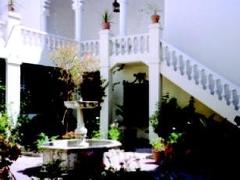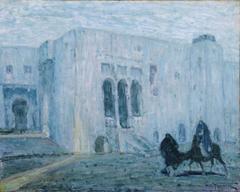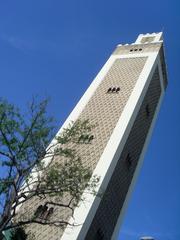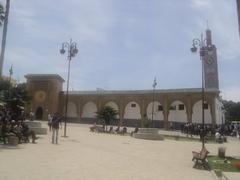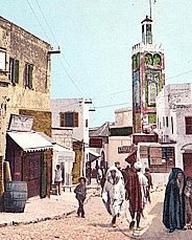Tingi Tangier, Morocco: Visiting Hours, Tickets, and Historical Sites Guide
Date: 14/06/2025
Introduction: Tingi Tangier’s Historical Significance and Visitor Appeal
Tangier—once known as Tingi—stands as Morocco’s legendary port city where Africa and Europe converge. Its remarkable setting on the Strait of Gibraltar has made it a crossroads of civilizations, drawing Berber tribes, Phoenician traders, Greeks, Romans, Andalusians, and European powers over the course of millennia (Maritime Heritage; Morocco World News). Each era has left an indelible mark on Tangier’s architecture, culture, and cosmopolitan spirit.
Today, Tangier enchants travelers with its ancient medina, iconic Kasbah, historic American Legation Museum (the only U.S. National Historic Landmark outside the United States), and natural wonders like the Caves of Hercules and Cape Spartel (Regency Holidays; Wiztour). The city’s vibrant culinary scene, lively festivals, and modern infrastructure further enhance its allure, making Tangier a top destination for history buffs, culture seekers, and adventurers alike.
This guide provides a detailed overview of Tangier’s historical sites, visiting hours, ticketing information, accessibility tips, guided tour options, and essential travel advice. Whether you’re planning your first visit or seeking to delve deeper into Tangier’s layered legacy, you’ll find practical insights and inspiration here.
Table of Contents
- Ancient Origins and Mythological Roots
- Roman and Early Islamic Eras
- Medieval and Early Modern Periods
- The International Zone and 20th-Century Cosmopolitanism
- Architectural Heritage and Urban Landscape
- Visitor Information: Hours, Tickets, and Travel Tips
- Tangier’s Cultural and Artistic Scene
- Modern Developments and Tourism Initiatives
- Top Attractions and Historical Sites
- Day Trips from Tangier
- Practical Visitor Tips
- Culinary Experiences and Food Tours
- Sample Itineraries and Day Trips
- Tangier’s Modernization and Evolving Identity
- FAQs
- Summary and Final Tips
- References
Ancient Origins and Mythological Roots
Tangier’s earliest roots trace to at least the 5th century BCE. According to Berber mythology, the city’s name comes from the goddess Tinjis, wife of Antaeus, while Greek legends associate it with the Titan Atlas (Pleiades). Phoenician sailors established early trading posts here as early as the 8th century BCE, recognizing the site’s strategic maritime location (Maritime Heritage; Morocco World News).
Roman and Early Islamic Periods
After the decline of Carthage, Tingi became a city of the Berber kingdom of Mauretania. By the 3rd century CE, it was a Roman colony and the capital of Mauretania Tingitana (Maritime Heritage). Visitors can explore Roman remains and mosaics in and around Tangier.
Following the Vandals and then the Arab conquest in the 7th century, Tangier became a major port and a gateway for the Islamic expansion into Spain. Its geographic position ensured its continual importance in commerce, culture, and military strategy.
Medieval and Early Modern Periods
From the 14th century, Tangier’s control shifted among European powers. The Portuguese captured it in 1471, and in 1661, it became an English possession as part of Catherine of Braganza’s dowry to Charles II (Morocco World News). The English period ended in 1684 after a Moroccan siege, returning Tangier to Moroccan rule (Maritime Heritage). Despite turbulent times, Tangier’s cosmopolitan spirit continued to evolve.
The International Zone and 20th-Century Cosmopolitanism
In 1911, Tangier was designated an international zone, governed by multiple foreign powers, reflecting its diverse population (Morocco World News). This period, lasting until Moroccan independence in 1956, made Tangier a magnet for diplomats, spies, artists, and writers—including Henri Matisse and Paul Bowles (Morocco World News). The city’s medina and legendary cafés inspired countless works of art and literature.
Architectural Heritage and Urban Landscape
Tangier’s architecture is a living record of its layered history. The medina’s winding streets, whitewashed walls, and bustling souks evoke centuries of Berber, Arab, and European influences (Shop of Morocco). The Kasbah, with its horseshoe arches and domes, dominates the skyline, while European colonial buildings line the Ville Nouvelle (Wiztour). The city is also home to historic mosques, synagogues, and the unique Tangier American Legation Museum (Wiztour).
Visitor Information: Hours, Tickets, and Practical Tips
Visiting Hours and Tickets
Most major attractions, such as the Kasbah Museum and Tangier American Legation Museum, are open from 9:00 AM to 5:00 or 6:00 PM. Ticket prices typically range from 20–50 Moroccan Dirhams (MAD), with some sites offering discounts for students and seniors. Guided tours are available for an additional fee and can be booked on-site or through local operators. Always check up-to-date schedules online or at visitor centers.
Accessibility and Travel Tips
Tangier is accessible via Tangier Ibn Battuta Airport and by ferry from Spain. While public transport and taxis are available, walking is the best way to explore the medina. Note that the medina’s cobbled streets and stairs can be challenging for those with mobility issues. The Ville Nouvelle offers more accessible options.
Guided Tours and Special Events
Walking tours of the medina, Kasbah, and themed food tours are available daily. Tangier’s festivals—such as the Festival of Mediterranean Cinema and Tanjazz—offer unique cultural immersion. Check event calendars to plan around special occasions.
Tangier’s Cultural and Artistic Scene
Tangier’s culture reflects a blend of Arab, Berber, Jewish, and European influences (Moroccan Foode). The city’s souks brim with traditional crafts and textiles, while contemporary art flourishes at venues like Yto Barrada’s Cinémathèque and the Contemporary Art Museum (Wiztour). Legendary cafés such as Café Hafa have hosted generations of artists and writers.
Modern Developments and Tourism Initiatives
Recent years have seen notable urban renewal projects—revitalizing the medina, beautifying the waterfront, and building modern hotels and malls—while preserving Tangier’s historic soul (Wiztour). Tangier’s population exceeds 900,000, and it welcomes more than 12 million visitors annually (Travel2Next). Ambitious development plans, including the Tanger-Med port and the Al Boraq high-speed train, have made the city more accessible than ever (Hadidari).
Top Attractions and Historical Sites
The Medina
The medina is the historic heart of Tangier, with maze-like alleys, lively souks, artisan workshops, and landmarks like the Grand Mosque (Regency Holidays). Entry is free, but fees apply for museums inside.
- Hours: Souks open 9:00 AM–7:00 PM.
- Highlights: Grand Mosque (exterior view only), traditional markets, historic gates.
The Kasbah and Kasbah Museum (Dar el Makhzen)
This hilltop citadel, once home to sultans, now houses the Kasbah Museum with Roman artifacts, Islamic ceramics, and palatial Moorish-Andalusian architecture (Morocco Tours Agency).
- Hours: Daily 9:00 AM–5:00 PM.
- Tickets: ~40 MAD.
- Accessibility: Some uneven surfaces.
Tangier American Legation Museum
A symbol of Tangier’s diplomatic history and the first U.S. public property abroad, this museum features art, diplomatic archives, and literary exhibits (Regency Holidays).
- Hours: Tuesday–Sunday, 9:00 AM–6:00 PM.
- Tickets: ~30 MAD.
Caves of Hercules
A legendary site west of the city, these natural sea caves are linked to the myths of Hercules and offer dramatic views of the Atlantic (Regency Holidays).
- Hours: 9:00 AM–6:00 PM.
- Tickets: ~20 MAD.
Cape Spartel and Lighthouse
Where the Mediterranean and Atlantic meet, this scenic headland features a 19th-century lighthouse and nature trails (Best Time To).
- Hours: Wednesday–Sunday, 10:00 AM–4:00 PM.
- Tickets: ~25 MAD.
Tangier Beach and Corniche
Urban beaches and the Corniche promenade provide relaxation, seaside cafés, and water activities (Regency Holidays).
Café Hafa
A cliffside café open since 1921 and a favorite haunt of artists, musicians, and writers (Journal of Nomads).
Cervantes Theatre
A grand, though currently closed, Spanish-era theater with a striking exterior (Morocco Tours Agency).
Contemporary Art Museum
Presenting modern works from Morocco and beyond, this museum is connected to the Kasbah Museum (Morocco Tours Agency).
Day Trips from Tangier
- Chefchaouen: The “Blue City” in the Rif Mountains, two hours away (MarocMama).
- Asilah: A coastal town famed for its art and whitewashed medina.
- Tetouan: UNESCO-listed medina with Andalusian heritage (Atalayar).
- Cape Spartel & Hercules Caves: Easily combined in a half-day trip.
Practical Visitor Tips
- Money: Cash (MAD) is preferred in most places. ATMs are widely available (Bewildered in Morocco).
- Transport: Petit taxis for short trips; grand taxis for longer distances. Trains and buses link Tangier to other cities (Attract Travel).
- Safety: Tangier is generally safe, but be aware of pickpockets and touts in crowded areas (Must Visit Morocco).
- Dress: Modest attire is recommended, especially in religious sites (Local Adventurer).
- Language: Arabic, French, Spanish, and English are spoken.
- Packing: Bring comfortable shoes, sun protection, and modest clothing.
Culinary Experiences and Food Tours
Must-Try Dishes
- Tagine: Morocco’s signature slow-cooked stew.
- Bissara: Fava bean soup, a local staple.
- Caliente: Chickpea tart, reflecting Spanish heritage.
- Seafood: Grilled sardines, calamari, and fresh catches.
(Moroccan Food Tour; Tangier Excursions)
Recommended Restaurants
- Palais Zahia: Renowned for authentic Moroccan cuisine (Art and Then Some).
- Restaurant Ahlan & Restaurant Soussi: Local favorites offering hearty traditional dishes (Levart Morocco).
Food Tours and Cooking Classes
Guided tours through the medina’s markets and street stalls are a highlight, offering tastings and insights into Moroccan culinary traditions (Moroccan Food Tour; Tangier Excursions). Many tours accommodate dietary restrictions.
Sample Itineraries and Day Trips
- 1 Day: Medina, Kasbah, American Legation Museum, Corniche, Café Hafa.
- 2 Days: Add a half-day trip to Cape Spartel and the Caves of Hercules.
- 3 Days: Full-day excursion to Chefchaouen or Asilah (Travel Morocco Today; Pinyourfootsteps).
- Multi-Day: Explore Tetouan, Fes, or embark on desert tours (TourRadar; All Morocco Tours).
Tangier’s Modernization and Evolving Identity
Tangier’s recent transformation includes the Tanger-Med port, Al Boraq high-speed rail, and urban renewal projects, positioning the city as a global gateway and economic hub (Hadidari; Vagrants of the World). Restoration efforts have revitalized the medina and waterfront, while the 2023–2026 tourism roadmap includes major projects to boost cultural and eco-tourism (Atalayar).
Tangier balances modernization with heritage preservation, maintaining its reputation as a cosmopolitan Moroccan city and a “gateway” between continents (Privatedrivermorocco).
Frequently Asked Questions (FAQ)
What are the best times to visit Tangier?
April, May, September, and October offer pleasant weather and lighter crowds (Travel Morocco Today).
Are guided tours available in multiple languages?
Yes—English, French, Spanish, and Arabic tours are widely available.
Is Tangier safe for tourists?
Tangier is generally safe, but take standard precautions against pickpocketing (Must Visit Morocco).
How do I buy tickets for museums and tours?
Tickets are available at entrances or online for some attractions; guided tours may include tickets (Regency Holidays).
Can I use credit cards?
Larger hotels and museums accept cards, but cash is recommended in markets and smaller venues (Bewildered in Morocco).
Summary and Final Tips
Tangier’s layered history, cultural diversity, and dynamic modern developments make it a captivating destination. From its mythological origins as Tingi to its role as an international crossroads, Tangier’s medina, museums, and natural wonders await discovery. Modernization and improved infrastructure have enhanced accessibility while preserving the city’s unique character (Hadidari; Atalayar). Travelers can enrich their visit by exploring local cuisine, joining guided tours, and planning trips to nearby towns and natural sites.
For up-to-date visitor information, downloadable maps, and insider tips, download the Audiala app (Audiala). Explore further resources and stay inspired as you prepare for your journey to Morocco’s iconic gateway city.
References
- Tangier Historical Sites: Visiting Hours, Tickets, and Travel Tips for an Unforgettable Journey, 2025 (Maritime Heritage)
- Tangier The Pearl of Africa, 2012 (Morocco World News)
- Explore the Historic Medina of Tangier: A Cultural Journey, 2025 (Shop of Morocco)
- Tangier’s Rich History & Cultural Heritage, 2025 (Wiztour)
- Top Must-See Sites and Attractions in Tangier, 2025 (Regency Holidays)
- Practical Visitor Tips and Culinary Experiences in Tangier, 2025 (Moroccan Food Tour)
- Tangier Travel Guide: Visiting Hours, Tickets, Day Trips, and City Highlights, 2025 (Travel Morocco Today)
- Tourism Roadmap 2023-2026 Major Projects in the Tangiers-Tetouan-Hoceima Region, 2024 (Atalayar)
- Tangier in 2025: A Growing Hub for Real Estate Investment, 2025 (Hadidari)
- [Additional sources as referenced throughout the article.]
